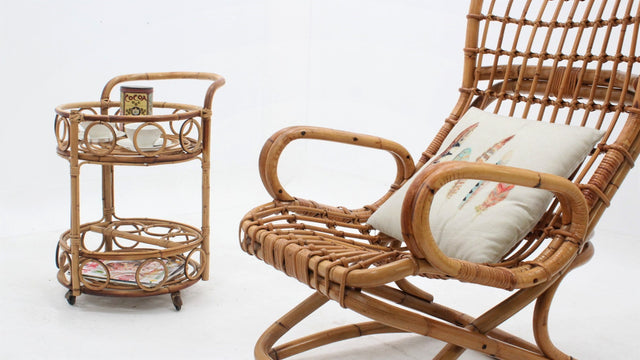...a piece of wood!
RUSH: These plants live mainly in wetlands and in the thick shady woods of maritime beaches.The main characteristics of this type of plant are gnarled or knotless stems, but above all It is slender and cylindrical.Its malleability makes this wood one of the most exported in the commercial sector. The leaves can be flat and linear or cylindrical, and the flowers appear in panicles;Sometimes the stigmas of the feathery flowers and the seeds of the rush can soften;they contain starches that make them sticky in contact with water.Rush can be used to make RATTAN, which is obtained by removing the surface part of the plant.
RATTAN: It grows in the equatorial zone of our planet such as South East Asia, Africa and Central America. It is the only existing plant with longitudinal lymph ducts and the only barrel-shaped plant on the planet.
It starts out thin, thickens in the middle and ends up thin again.It grows wild in forests, crawls on the ground, climbs trees and ends its growth where it reaches the light.
Its length can exceed 100 metres and its diameter can be as much as 500 mm.
Harvesting the tree does not affect the ecological balance, instead it protects trees that may be choked by the growth of RATTAN itself.
Thanks to its leaves, which are characterised by a hook-shaped end, local populations claim that this plant was discovered and initially harvested for angling.
These "hooks" have always made harvesting RATTAN a laborious and tiring process. It has to be cut at the base and pulled off leaf by leaf, starting from the end.
Great Britain and Holland were the first countries to display RATTAN furniture in their homes as a symbol of colonialism and knowledge of distant cultures.
RATTAN made its appearance as a working material in Italy around the 1940s:
It was first used to replace wicker for the woven parts and then chestnut for the structure.
BAMBÚ: Among the numerous 'families' into which the plants of the Earth have been grouped,the Gramineae occupy a place of first order.
They are commonly without stems or woody branches, partly because they are considered to be herbaceous plants, but they differ from them in several ways. Their stems are smalland usually hollow. The leaves are attached to the stem with a 'sheath' that wraps around the stem. There are no flowers but ‘spikes’. The fruit is the part of the plant that contains the nutrients the plant needs to survive. Among the main industrial gramineae is bambú, mistakenly called 'bamboo' or 'bambu'. This plant grows in tropical and humid areas of Asia and America.
There are many species of bambú, almost all of which have large stems with walls containing a large amount of silica.
This material has been used extensively since ancient times. One example is in the creation of paperwhere the silk-water mixture was filtered through bambú mats.
Further applications of this extraordinary material are mainly present in the commercial field.
Thanks to its extraordinary lightness, it is nowadays used in the construction of rafts as well as in the production of bows.
The largest producer of this 'wood' is China, which uses it in the production of baskets, furniture and mats, as well as in the construction of their traditional houses.
WICKER: term of Latin origin 'vimen’ which means 'intertwining'. Wicker is the young branches of some species of willow, typical tree of waterways. Wicker is uprooted during the winter. If it is debarked, it will take on the typical brown color as it dries up; if instead the branches are left to soak all winter, once peeled and dried they will take on a light color. Rehydration is also required for these fibers to allow processing: wicker is left to bath for about 3-4 hours and kept moist with a wet cloth.
It has always been the favorite material of basket craftsmen for the construction of their artifacts.
MIDOLLINO is obtained by drawing the internal part of the rush, in different diameters, in the round or flat-oval version.
Wet and subsequently woven, it allows you to create textures with the most varied designs.
It is suitable for coloring.
After all,it's alwais a pity to buy any piece of forniture without basing one's choise on something more than mere "taste".
Choose from my selection the objects that are right for you!



0 Comments
There are no comments yet. Be the first one to post one!